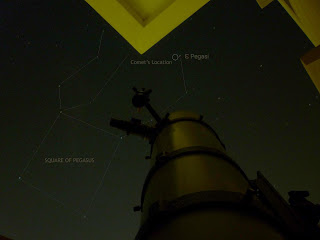OBSERVING REPORT OF COMET C/2009 P1 GARRADD
 |
| computer generated drawing of comet Garradd |
On July 28th around midnight I planned to observe comet C/2009 P1 Garradd. This is the brightest comet in the current sky and I wanted to observe this comet since a month. Unfortunately during this time of a year we get no cloud-free session of observing. But I got lucky on the night of 27th. The sky became clear after sunset. It rained in the noon time and was light shower before sunset but just after sunset the clouds began to move away leaving patches of the orange sky in the West. At 11:00pm of 27th I saw stars in the zenith and also the Scorpius appeared in the south. The stars appeared crystal clear in many parts of the sky.
When I was sure that there will be no interruption of clouds I uncovered my 25x100 Binoculars. I settled the tripod in my home’s balcony, where I spend many sessions of visual comet hunting. The balcony faces toward East. I saw beautiful Cygnus, Lyra, Altair and Cassiopeia. The Great Square of Pegasus was well above the East. The comet is currently in Pegasus and it is close to the star Epsilon Pegasi (Enif). The star was very high near the upper floor’s balcony of the apartment. So I had less time to observe this comet.
I pointed the binocular to Enif (Epsilon Pegasi) and scanned the area around the star. I had no idea where exactly the comet was. In the early morning I checked its position in the Starry Night software and knew that it was a couple of degrees NW from the star. So I scanned there. Only after few seconds I spotted something fuzzy, very close to a 8th magnitude star. In the wider field of the binocular it was rather difficult to make sure that it was a comet. I spent few minutes to observe it and then I was sure that it is a comet. I then decided to observe it through a bigger aperture. I put my binocs back and uncovered my 8-inch Newtonian Telescope. Observing that object using a 40mm Plossl eyepiece I could clearly see that it was a comet. At 76x using a 17mm Plossl I saw very bright nucleus.
My observation lasted for half an hour and I detected its motion too. It was moving toward west. Its distance from that 8th magnitude star increased of about 1 arc minute. As per my observing experience I could decide that it was shining at 8th magnitude. This comet will be the best binocular object during September as it is approaching magnitude 6.
check the finder chart of the comet
check the finder chart of the comet

Comments